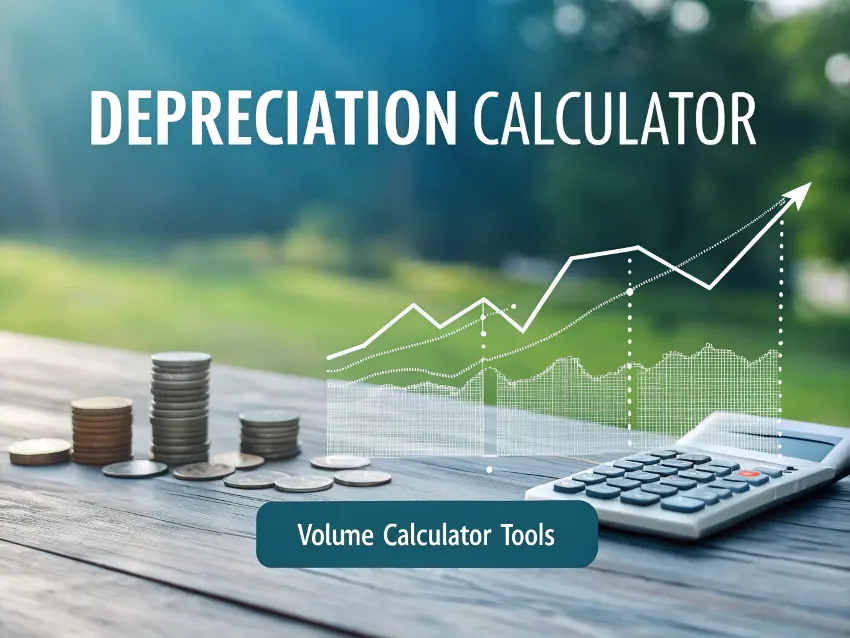Depreciation Calculator
Calculate asset depreciation using different methods

Asset Depreciation Calculator
Understanding Depreciation:
Depreciation represents the decrease in an asset's value over time due to wear and tear, obsolescence, or other factors. For accounting and tax purposes, businesses can spread the cost of an asset over its useful life.
Different depreciation methods allocate an asset's cost differently, affecting taxable income and financial statements in various ways.
Depreciation Methods:
Straight-Line Depreciation
The simplest method that allocates an equal expense each year. Annual depreciation = (Cost - Salvage Value) ÷ Useful Life.
Declining Balance Method
Accelerated depreciation with more expense in early years. Calculated by applying a constant rate to the remaining book value.
Sum-of-Years-Digits
Another accelerated method using a fraction with remaining life in the numerator and sum of years in the denominator.
MACRS (Modified Accelerated Cost Recovery System)
The standard depreciation system for U.S. tax purposes, with predefined recovery periods and rates for different asset classes.
Key Terms
- Cost Basis: The original cost of the asset, including taxes, shipping, and setup costs.
- Salvage/Residual Value: The estimated value of the asset at the end of its useful life.
- Useful Life: The estimated period an asset is expected to remain in service.
- Book Value: The asset's value on the books (Cost - Accumulated Depreciation).
- Accumulated Depreciation: The total depreciation recorded for an asset since acquisition.
Calculate Asset Depreciation
Asset Information
$
$
Depreciation Method
Depreciation Results
Depreciable Base:
$0.00
Cost minus Salvage Value
Total Depreciation:
$0.00
Over 0 years
Avg. Annual Depreciation:
$0.00
0.00% of cost per year
Depreciation Schedule
| Year | Depreciation Expense | Accumulated Depreciation | End Book Value | Rate |
|---|
Depreciation Visualization
Method Comparison
This chart shows how your asset would depreciate using different methods for comparison.
Tax & Accounting Considerations
Financial Reporting vs. Tax Depreciation
Financial Reporting (GAAP/IFRS)
- Focuses on matching expenses with revenue periods
- Uses economic useful life estimates
- Common methods: Straight-line, units of production
- Requires annual impairment testing
- Residual value is usually considered
Tax Depreciation
- Focuses on tax deductions and incentives
- Uses prescribed recovery periods (e.g., MACRS in the U.S.)
- Accelerated methods often preferred to defer taxes
- May allow bonus depreciation or Section 179 expensing
- Residual value usually ignored for tax purposes
Strategic Depreciation Choices
1
Cash Flow Optimization
Accelerated methods like double-declining balance provide larger tax deductions in early years, improving cash flow when it matters most—during the initial investment recovery period.
2
Income Smoothing
Straight-line depreciation spreads expenses evenly, which can help maintain consistent earnings reports, potentially appealing to investors who value stability.
3
Asset Replacement Planning
Aligning depreciation periods with actual replacement cycles helps ensure adequate funds are available when assets need replacement.
4
Tax Strategy
Consider current and future tax rates. If you expect higher tax rates in the future, deferring deductions with slower methods might provide greater savings later.
U.S. Tax Incentives (2023)
Section 179 Expensing
Section 179 allows businesses to deduct the full purchase price of qualifying equipment in the year it's put into service, rather than depreciating it over time.
- 2023 Limit: Up to $1,160,000 of equipment can be expensed
- Phase-out: Begins when purchases exceed $2,890,000
- Eligible property: Most business equipment, office furniture, computers, off-the-shelf software
- Considerations: Must have taxable income to use (can't create a loss)
Bonus Depreciation
Bonus depreciation allows businesses to deduct a large percentage of the cost of eligible assets in the first year.
- 2023 Rate: 80% of the asset's cost can be depreciated in the first year
- Phase-down Schedule: 60% in 2024, 40% in 2025, 20% in 2026, then expires
- Eligible property: New and used property with a recovery period of 20 years or less
- Advantages: Can create or increase a loss, no dollar limit
Vehicles: Special Considerations
Business vehicles have different depreciation rules and limits based on their type and weight.
- Passenger Vehicles (2023): Limited to $19,200 in the first year (with bonus)
- SUVs over 6,000 lbs: Can use Section 179 up to $28,900, plus bonus depreciation on the remainder
- Heavy Vehicles (over 6,000 lbs GVW): Often eligible for full Section 179 and bonus depreciation
- Electric Vehicles: May qualify for additional tax credits
Note: Tax laws change frequently. This information is based on 2023 tax rules. Always consult with a qualified tax professional before making business decisions based on tax considerations.